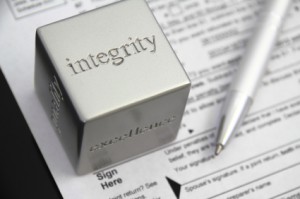 In my last post, Building the Trust-based Organization Part I, I suggested that approaches to trust at the organizational level fell into several categories. Like the parable of the blind men and the elephant, all captured some part of the puzzle, but none grasped the entirety of the issue. The five categories I listed were:
In my last post, Building the Trust-based Organization Part I, I suggested that approaches to trust at the organizational level fell into several categories. Like the parable of the blind men and the elephant, all captured some part of the puzzle, but none grasped the entirety of the issue. The five categories I listed were:
1. Trust as communication
2. Trust as reputation
3. Trust as recipe
4. Trust as rule-making
5. Trust as shared value.
I suggested a holistic approach would have a Point of View, a Diagnosis, and a Prescription. Here is my attempt to offer such an approach.
Organizational Trust: A Point of View
Trust relationships are asynchronous – one party, the trustor, is the one who does the trusting, and who takes the risks. The other party, the trustee, is the one whom we speak of as being trustworthy. “Trust” is the result of a successful interaction between these two actors.
Trust is largely an interpersonal phenomenon. Trustworthiness is mostly personal, though we do speak of ‘trustworthy’ companies as having a track record or being reliable. Trusting, however, is a completely human action, not a corporate one.
Risk is necessary to trust: if risk is completely mitigated, we are left only with probability.
It follows that the most powerful meaning of “organizational trust” is not an organization that trusts or is trusted, but an organization that encourages personal trust relationships:
A trust-based organization is an organization which fosters and promotes the establishment of trust-based relationships between various stakeholders – employees, management, shareholders, customers, suppliers, and society.
Organizational Trust: Diagnosis
What is needed to create a trust-based organization? Since ‘trust’ is such a broad concept, it’s clear that themes like communications, regulations, and customer relationships will have a role. But to avoid a mere laundry list, what’s needed is some kind of primus inter pares relationship; or perhaps some necessary vs. sufficient distinctions.
My nomination is simple: an agreed-upon system of Virtues and Values. Virtues are personal, and represent the qualities sought out in employees and managers. Values are organizational, and reflect basic rules of relationship that ought to govern all relationships within the organization.
Some typical trust-based virtues include: candor, transparency, other-orientation, integrity, reliability, emotional intelligence, empathy.
I have suggested elsewhere Four Trust-based Organizational Values. They are expressed below in terms of customer relationships just to be specific, but they apply equally to relationships with suppliers, fellow-employees, and so forth.
- Lead with customer focus – for the sake of the customer. Begin interactions with other-focus rather than self-focus.
- Collaboration rather than self-orientation. Assume that the customer is a partner, not in opposition to us. We are all, always, on the same side of the table.
- Live in the medium-to-long term, not the short term; interact with customers in relationship, not in transactional mode. Assume that all customers will be customers in perpetuity, with long memories.
- Use transparency as the default mode. Unless illegal or hurtful to others, share all information with customers as a general principle.
Advocates for Values. I am not alone in citing Values as lying at the heart of the matter. McKinsey’s Marvin Bower put values at the center of his view of business, and McKinsey for many years was run from his mold. As Harvard Business School Dean McArthur said of Bower, “What made him a pioneer was that he took basic values into the business world.”
In 1953, Bower said, “…we don’t have rules, we have values…”
In 1974, he wrote, “One of the highest achievements in leadership is the ability to shape values in a way that builds successful institutions. At its most practical level, the benefit of a managed value system is that it guides the actions of all our people at all levels and in every part of our widespread empire.”
Bower’s biographer noted that Bower believed that “while financial considerations cannot be ignored, business goals must not be financial; if they are, the business will fail to serve its customers and ultimately enjoy less profit.”
The alumni of McKinsey – some, anyway – learned well. Harvey Golub said, “[values are] a powerful way to build a business…it worked for McKinsey and it worked for IDS and for American Express.”
IBM’s Lou Gerstner said: ‘“I believe that I learned from [Marvin] the importance of articulating a set of principles that drive people’s behavior and actions.”
[Note: McKinsey itself had some noticeable hiccups post-Bower. In my view, this is not an indictment of values-based management, but a sad example of how it requires constant values-vigilance].
The Case for Values. The use of values as the basis for management is well-suited to the subject of trust, and this advantage shows up in numerous ways.
- Values scale, in a way that performance management systems never can do.
- Values are about relationships, in a way that incentives never can be; this makes them highly suitable to the subject matter of trust.
- Values are infinitely teachable, in a way that value propositions or communications programs alone cannot aspire to.
- Values are among the most un-copyable of competitive advantages.
Organizational Trust: Prescription
Managing a values-based organization will center around keeping the values vibrant. This is pointedly not done mainly through compensation and reward systems, corporate communications plans, or reputation management programs. Instead, it is done through the ways in which human beings have always influenced other human beings in relationship. To name a few:
- Leading by example: trustworthy leaders show the way to their followers by their actions, not just their words
- Risk-taking: trusting others encourages them to be trustworthy, and, in turn, to themselves trust others
- Discussion: principles undiscussed are principles that die on the vine. Discussion, not one-to-many communication, is key to trust
- Ubiquitous articulation: trust principles should underpin many corporate decisions and actions; trust-creating leaders seize the opportunity for teaching points in every such case
- Recognition: Public praise for values well-lived is intrinsically motivating
- Confrontation: Trust-building leaders do not hesitate to overrule business decisions if they violate values, and to do so publicly in ways that teach lessons. Values, not value, are the ultimate arbiter of all actions.
To sum up: it’s a simple concept. Trust in a corporate setting is achieved by building trust-based organizations. Trust-based organizations are built to consciously increase the levels of trusting and of trustworthiness in all organizational relationships. The best approach to creating such an organization is values-based management and leadership. This is different from most approaches to management and leadership in vogue today.
The quotes about Marvin Bower were taken from:
Edersheim, Elizabeth Haas (2007-12-10). McKinsey’s Marvin Bower: Vision, Leadership, and the Creation of Management Consulting. Wiley.


 In my last post,
In my last post,  Do your eyes glaze over at that title? Mine do. I always click on such titles, but am usually disappointed when I get what feels like low-content or high fluff-quotient material. So I set out to tighten up the perspective.
Do your eyes glaze over at that title? Mine do. I always click on such titles, but am usually disappointed when I get what feels like low-content or high fluff-quotient material. So I set out to tighten up the perspective. I wrote a good blog post at this time seven years ago, and haven’t improved on it yet. Here it is again.
I wrote a good blog post at this time seven years ago, and haven’t improved on it yet. Here it is again. Like trust, integrity is something we all talk about, meaning many different things, but always assuming that everyone else means just what we do. That leads to some vagueness and confusion. But a careful examination of how we use the words in common language is useful.
Like trust, integrity is something we all talk about, meaning many different things, but always assuming that everyone else means just what we do. That leads to some vagueness and confusion. But a careful examination of how we use the words in common language is useful. The headlines, surveys and news stories are everywhere. Trust is down – in world leaders, in legislatures, in financial institutions, doctors, even religious leaders and educators. It is very, very easy to draw one conclusion from all this – that we have a crisis of trustworthiness.
The headlines, surveys and news stories are everywhere. Trust is down – in world leaders, in legislatures, in financial institutions, doctors, even religious leaders and educators. It is very, very easy to draw one conclusion from all this – that we have a crisis of trustworthiness.